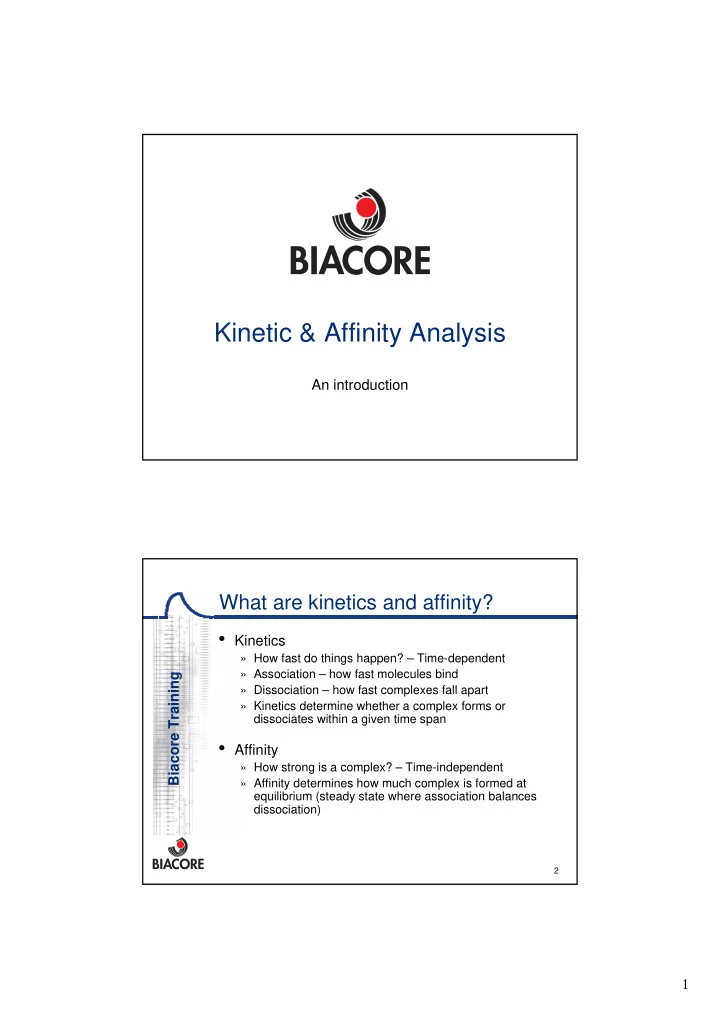

Kinetic & Affinity Analysis An introduction What are kinetics and affinity? • Kinetics » How fast do things happen? – Time-dependent » Association – how fast molecules bind Biacore Training » Dissociation – how fast complexes fall apart » Kinetics determine whether a complex forms or dissociates within a given time span • Affinity » How strong is a complex? – Time-independent » Affinity determines how much complex is formed at equilibrium (steady state where association balances dissociation) 2 1
What is the relevance of binding kinetics? • The cell is a dynamic system – rarely in equilibrium • The same affinity can be resolved into different on Biacore Training and off rates for different interactions » Kinetic data reveal more information 3 Same affinity but different kinetics • All 4 compounds have the same affinity K D = 10 nM = 10 -8 M • The binding kinetic constants vary by 4 orders of magnitude Biacore Training Concentration = 1000 nM Concentration = 100 nM All target sites k on k off occupied (M -1 s -1 ) (s -1 ) Response 10 6 10 -2 10 5 10 -3 10 4 10 -4 10 3 10 -5 30 30 60 60 min min min min Time Time 4 2
Three ways to obtain kinetic and affinity data in Biacore • Monitor association and dissociation rates » Affinity Kinetics Biacore Training • Monitor steady state levels » Affinity Kinetics • Measure free analyte in solution » Affinity Kinetics 5 Rate equations for 1:1 kinetics k a A B AB k d B Biacore Training A d [AB] k a [A] [B] Association: dt B -d [AB] k d [AB] A Dissociation: dt Net rate equation: d [AB] k a [A] [B] k d [AB] dt M -1 s -1 M M -1 M M/s s where -1 -1 k a association rate constant [M s ] -1 k d dissociation rate constant [s ] 6 3
Equilibrium constants At equilibrium: Association Dissociation Biacore Training k a [A] [B] k d [AB] -1 -1 -1 M s M M s M The equilibrium constants: k a [AB] -1 K A the equilibrium association constant [M ] k d [A] [B] k d [A] [B] K D the equilibrium dissociation constant [M] k a [AB] 7 Equilibrium and kinetics in Biacore k a A + B ⇔ AB k d Biacore Training • A is the analyte in solution » Free concentration maintained constant by flow system • AB is the complex » Concentration of complex measured directly as R in RU • B is the ligand on the surface » Total concentration can be expressed in RU, as maximum binding capacity R max » Free concentration is R max -R We do not need to know the “real” concentration of ligand or complex 8 4
Rate and affinity in Biacore terms k a A B AB k d Biacore Training d [AB] k a [A] [B] k d [AB] dt dR k a C [R max R] k d R dt -1 -1 -1 M s s RU/s M RU RU A has one binding site and reacts with immobilized ligand B has n identical and independent binding sites 9 The net rate equation terms in a sensorgram Biacore Training 10 5
Information in a Sensorgram • The relationship between R max , R eq and K D Biacore Training 11 Mass transport • A phenomenon with relevance to kinetics measurements in Biacore » Describes the movement of molecules from solution Biacore Training to a surface » Is independent of biomolecular interaction processes • Rates measured in Biacore depend on both mass transport and biomolecular binding » The relative importance of mass transport effects can be largely controlled by the assay conditions used 12 6
What is mass transport? • Diffusive mass transport » Simple example in a static system Biacore Training analyte gradient • Over time, analyte concentration at the surface will be depleted and a gradient will be generated through the liquid layer 13 Analyte consumption & supply flow cell height Biacore Training 1 diffusion 2 distance 3 1. Analyte supplied by convection (continuous flow) 2. Diffusion becomes increasingly important as the flow rate reduces closer to the surface 3. Biomolecular interaction processes at the ligand/analyte interface 14 7
Dealing with mass transport limitations • Low R max (ligand density) Biacore Training • High flow rates » High flow rates reduce diffusion distance • Mass transport correction included in all kinetic models 15 Experimental Design 8
Experimental design Affinity determination by steady-state analysis • Determine steady state binding levels over a range of analyte concentrations • High immobilization level Biacore Training • Concentration range should cover at least 20-80% saturation of the surface • Use reference surface • Include at least one concentration in duplicate • Include zero concentration sample 17 Important experimental parameters Kinetic analysis • The purity of the reagents • Immobilization procedure • Immobilization level Biacore Training • Ligand activity • Flow rate • Analyte concentration range 18 9
Analyte concentrations Kinetic analysis • Concentrations should cover a full range of binding curves • Include at least one concentration in duplicate Biacore Training • Include zero-concentration samples 19 Summary B • Affinity analysis A » Derives the affinity constants Biacore Training » For analysis of interactions with very fast on and off rates • Kinetic analysis » Derives the rate constants and the affinity constants » For detailed characterization of a molecular interaction » Interactions with the same affinity may have entirely different association and dissociation rate constants » Rate constants may be more significant than affinity in understanding biological processes 20 10
Recommend
More recommend